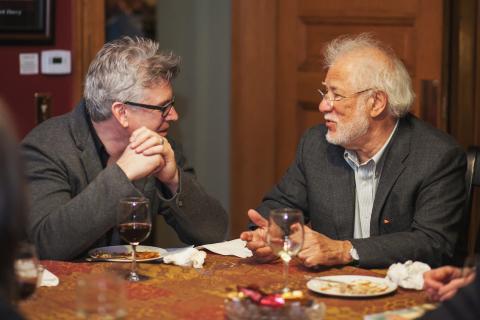
by Corey Dahl
Most of us first discovered Michael Ondaatje on a book shelf, picking up In the Skin of a Lion or Anil's Ghost. Or at the movie theater, watching the film adaptation of The English Patient.
Lighthouse instructor Bill Henderson's first meeting with Ondaatje, though, occurred in the flesh, at what might be one of the coolest, most literary dinner parties I've ever heard of.
"I actually met him before I read him," Henderson said. "I’m not sure I knew much about him at the time. I think it was 1989. I was teaching at Brown University, and Robert Coover had me over to dinner to celebrate some good news I’d just received. Edmund White was also there, and who should just happen to drop by but Michael Ondaatje, passing through on his way somewhere."
Did Ondaatje stay for dinner? Henderson can't remember. He does remember that the other writers recommended his work—"He's poetic and smart, they told me"—so he sought it out.
More than two decades later, Henderson is still an Ondaatje fan, and on March 19, he'll get to meet with the author again—this time live and onstage, as our Inside the Writer's Studio host.
Ahead of Ondaatje's visit, I talked to Henderson about the writer, his work, and the craft elements that make him a stand-out. Listen in on our chat and then check out all the events leading up to and including Ondaatje's visit to Lighthouse next month.
Q. What's the first work you read of Ondaatje's? What kept you reading?
A. I think I picked up In the Skin of a Lion first—it had just recently come out—though I can’t say what my impression was other than I thought it was beautifully written. This was many years ago. There are images from that novel that have stuck with me, and they regularly come to mind. I don’t know what they mean or even who the characters were who were involved in the scenes, but they have imprinted so strongly that they seem to be part of my own life experience. One involves someone falling from a bridge that’s under construction, and sometimes I think that someone I know has had such an accident.
Then The English Patient came out, and, again, the writing was gorgeous. (As if you need me to tell you this.) Plus the story was vast and romantic and seemed more complex than in In the Skin of a Lion—though, really, all his novels are wonderfully layered and complex. (I was too young to know much, and now I’m a little older.)
What kept me reading? The way he juxtaposes fragments of various stories to create a perfect tapestry.
https://www.youtube.com/watch?v=3gBVILOsetU
Q. Do you have a favorite Ondaatje book?
A. I haven’t read them all, though I’ve read most of them. I’m looking forward to reading Divisadero. I just finished The Cat’s Table. I’ve found favorite moments in each of them so far, but it’s really his writer’s brain that I love.
I was reading Anil’s Ghost recently, and different sections of information kept popping up unexpectedly. Or, for a while, we’d follow a character who didn’t seem vital to the plot. Always, though, that bit of information or a character’s particular experience would inform and deepen something core that ran through the whole novel.
There’s a section about how someone paints a Buddha statue’s eyes—he can’t look directly at the statue, but must look at the eyes through a mirror as he paints. That brief scene, following the painter’s careful procedure, spoke to me more about how we deal with tragedy and brutality than many of the more graphic scenes of brutality in the Sri Lankan civil war.
The Collected Works of Billy the Kid includes a brief passage (all its passages are brief) in which Billy lies sick in a barn for a few days, then rouses himself and shoots dead a hoard of rats. Which sounds minor and gross, but it’s pretty spectacular.
For all the charm of the ocean voyage at the heart of The Cat’s Table, one moment that particularly stuck with me is a reference to how a woman sits at her window in her house on a Canadian island and watches the ferries cross the water. It summed up the narrator’s whole narrative stance as he relates his childhood voyage and how it has resonated for him. So I guess they’re all my favorite.

Q. Let’s say Writer’s Studio happens to coincide with the apocalypse, and you only have time to ask Ondaatje one question. What would it be and why?
A. I’m almost sure that if the world were ending I’d have some pretty serious questions to ask myself. But if the zombies forced me to ask Ondaatje a question, I think it would be about the process of getting from interest, character, and obsession to a tightly woven tapestry. But isn’t that always the question? That’s certainly why I read—to try to follow someone else’s synapses, to try to figure out if I’m the same type of human being as the author or even a human being at all.
Q. What does Ondaatje do better than any other writer, in your opinion? What skill/technique of his would you like to steal for yourself?
A. It’s that weaving, the tapestry, the variety of voices. The sheer number of voices is daunting. I usually only have one voice in my head, and it’s usually saying, “Why’s it so quiet in here?”
Michael Ondaatje will visit Lighthouse March 19-20. To learn more, click here!

